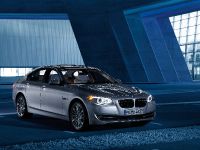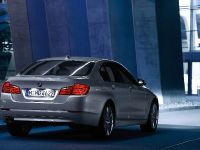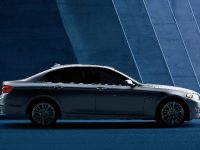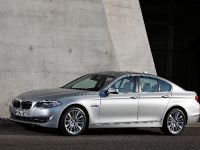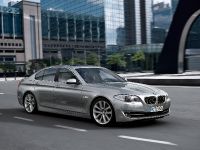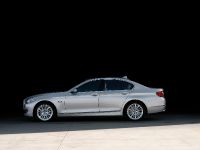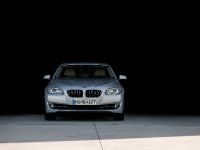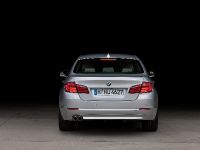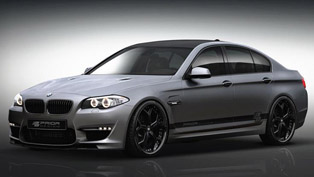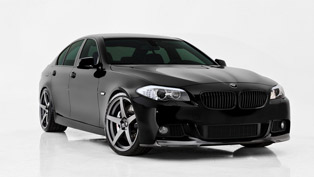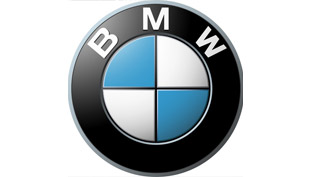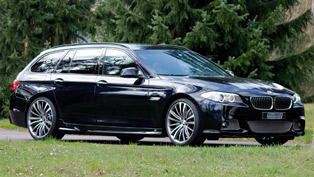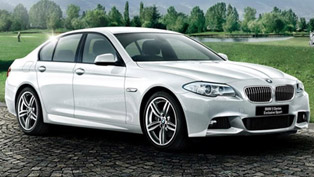BMW unveiled the new 5 series F10
BMW started production of the first 5 series - E12 back in 1972. Since then BMW release four more models of the 5 series. The second was E28, which was introduced 1982. In 1988 came out the revolutionary E34, which is still driven all over the world. The fourth generation of 5 series is E39, which was released in 1996. The last model, which is still in production is E60 - one of the best-selling premium cars in the world. Now BMW unveiled the newest 5 series - F10.
The world debut of F10 is a significant event in automobile industry. The new 5 series includes modern design and unique driving experience.
Cars from last decade became more and more powerful, especially in the premium midsize segment and BMW F10 is not an exception. There are also number of electronic systems, which help the driver to achieve better handling. The Adaptive Drive, which includes Driving Dynamics Control, Electronic Damper Control, and Active Roll Stabilization is part the sport package for F10. Active Steering is available as an option, but there are a lot of negative comments about it from drivers, which tested it in some previous models of BMW.
BMW F10 will be available with two petrol engines at its launch. The very famous 3.0 liter inline-six with a single twin-scroll turbocharger, which develops 300hp and 406Nm of torque will be built-in 535i. The other is a mighty 4.4 liter V8 featuring twin turbochargers and High Precision direct injection developing 400hp and 610Nm of torque. Both engines are available will a choice of 6-speed manual gearbox and BMW's new 8-speed automatic transmission.
Later, the 528i model will be presented with 240hp inline-6 featuring VALVETRONIC throttle-less intake technology.
BMW spent a lot of money and time in researching advanced technologies to improve their automobiles. Efficient Dynamics technologies include features such as Brake Energy Regeneration, Electric Power Steering, a gearshift point indicator, active cooling air flaps, and on-demand operation of engine accessory drives. By making doors, hood, front fenders, and suspension assemblies from aluminum engineers achieved perfect balance of the vehicle's weight.
The option list is so long, that you will need several hours to go through it and choose the additional equipment. There are a lot of driver assistance systems such as an all-new Parking Assistant, Top View cameras, and Frontal Collision Warning with application of the brakes when ordered with Active Cruise Control plus Stop & Go., besides these BMW offer Blind Spot Warning, Lane Departure Warning, a Head-Up Display, BMW Night Vision with Pedestrian Detection.
Since the first 5 series was introduced, BMW sold more than 5.5 million units through the generations. The F10 model shares components and technology with the latest BMW 7 series to ensure highest standards of quality.
BMW always made perfect proportions for their vehicles. The F10 features are long wheelbase and hood, short overhangs, aft-set greenhouse, and the coupe-like flowing roofline. The car is stylish and in the same time aggressive. Of course, F10 also includes BMW's signature Hofmeister kink at the bottom of the C-pillar.
The wheelbase of BMW F10 is the longest in the segment measuring 2.97 meters, which gives the car extraordinary good road behavior and comfort for the passengers. Besides that the weight distribution between the front and the rear axle is almost perfect.
A lot of hardcore fans dont like the new exteriors of BMW cars, but you cant stay unimpressed by the F10 series. The daytime running lights underline the style in the front of the car, they also differentiate BMWs from the other cars. When you drive on the road in other car and see in the rearview mirror the four rings something makes you feel a respect from the car and you know that is a BMW.
It is not enough to create an aggressive and stylish front of a car to make it pretty and there are a lot of examples, which look awful at the back. The designers gave BMW F10 unmistakable night design by creating L-shaped rear light clusters with LED technology. There are three rows of LED lights for rear lamps, the direction indicators and brake lights also come in LED.
The dynamic lines of the car are further enhanced by the strikingly compact counter-swing at the bottom of the C-pillar. Featuring the smallest radius at this point ever to be seen on a BMW sedan, this re-interpretation of the typical Hofmeister kick underlines the stretched silhouette of the car and gives the passenger cell a light and low appearance.
Inside the F10 series is a real furore. Typical for the early models of BMW bend of the center console is now available in the new five series, also the cockpit is inclined towards the driver at an angle of approximately 7o . Everything is created to be in one hand distance from the drivers seat, so operating with air conditioning, I-drive and the sound system. All displays, knobs and buttons serving comfort functions are situated centrally for use by the driver and front passengers. Another very important extra is a power tilt and telescopic adjustment and tilt-away for exit and entry of the steering wheel. Further more both front seats come standard with 10-way power adjustment including head-restraint height.
The seating position has been improved over the former model both front and rear, with knee-room on the rear seats of the new BMW 5 Series Sedan up by 13mm. Luggage compartment capacity is 520 litres. There are also an option for folding rear-seat backrest. In addition to its 40:60 split, the rear-seat backrest also comes with through-loading and, as yet a further option, a ski-bag for additional convenience.
BMW F10 comes with 4th generation iDrive, which is more intuitive, more powerful and faster than its predecessors. The system is available in in two versions: with 7.0" dimensions and 800 x 480-pixel resolution in standard form, or with the optional Navigation system, in a 10.2", 1280 x 480-pixel version with a wider range of features and functions as in the new BMW 7 Series. Displays are transreflective so that light from the sun actually enhances the images on the screen.
The luxury in F10 is at incredible high level, which is further enhanced by choices of colors and material. For the dash's finely grained upper section, there are two colors depending upon the chosen interior color. Dakota leather is standard on the 550i model, and available in six color schemes of which three are new; BMW's luxurious Nappa leather is optional, and available in three color schemes. Dark Burl Ash wood is a standard trim on the dash, doors and front center console. Optional trims are Ash Anthracite (gray tone) and Fineline Matte.
The center console is available in two completely different variants. On the cars with a manual gearbox, it is split into two sections, the black surface surrounding the gearshift lever and the buttons on the optional Driving Dynamics Control oriented towards the driver. A key holder has been placed between the gearshift lever and the climate controls.
The second variant is on the cars with automatic transmission, where e space between the electronic gear selector lever and the climate control unit offers enough room for two cupholders and a key holder. There are also additional storage compartment behind the iDrive Controller.
BMW F10 will be available in the United States with a choice of three gasoline engines. At the introduction of the car, the new 5 Series will be available as a 535i and 550i. The 528i and xDrive all-wheel drive variants of all three models will arrive later in the year.
F10 550i is powered by BMW's well-know 4.4 liter twin-turbocharged V8 engine. The result is more than satisfying - 400hp over a range from 5500 to 6400 revs per minute and maximum torque of 610Nm available over the extremely broad range of 1800 to 4500 rpm. The classic discipline from 0 to 60mph is covered in 5.0 seconds and the top speed is 241km/h for cars equipped with the Sport Package. For models without Sport Package the maximum speed is limited to 210km/h.
F10 535i will be powered by BMW's newest 3.0 liter gasoline inline-6 engine with single, twin-scroll turbocharger. The BMW's EfficientDynamics technologies featured in this engine are VALVETRONIC throttle-less intake technology and High Precision direct injection. The combination guarantees improved throttle response from idle to redline, reduced fuel consumption, and substantially reduced emissions. The maximum power is 300 hp at 5800 revs per minute and 406Nm of torque is available from 1200 rpm – 5000rpm.
Another innovation, which will be built-in the new BMW 5 Series is an 8-speed automatic transmission, which is designed to bring smoother shifting, sportiness and efficiency.
Technically speaking, this new automatic's attributes have been achieved via an innovative concept that provides the two additional ratios ( 7 and 8 ) with no increase in bulk or weight. In an arrangement not heretofore employed in an 8-speed automatic, four planetary gearsets and five clutch packs are controlled in a way that no more than two of the five clutch packs are freewheeling at any given time. The modest increase in the number of mechanical elements allows the new transmission to achieve unusually high efficiency: the so-called "gearing efficiency" is higher than 98% in all eight gears. In 6th gear, it's highest of all because that is direct drive, with no gearing reduction at all. Combine this with reduced friction and the ability to keep the torque converter "locked up" more of the total driving time, and the transmission becomes very much a part of the new 5 Series' overall efficiency concept. Behind all these complex words are hidden just few things - better acceleration, lower fuel consumption and more comfort for the occupants due to reduced noise at higher speeds.
F10 535i and 550i Sedans will be offered with a 6-speed manual transmission in the United States.
The innovations in the new BMW 5 series dont end with the engines, EfficientDynamics technologies, better iDrive system and the new automatic gearbox. There are an energy-saving innovation called Brake Energy Regeneration system. It is designed to reduce the vehicle's fuel consumption over time.
Conventionally, a car's alternator runs continuously and thus is always charging the vehicle's battery. In the new 5 Series, it charges only when the vehicle is decelerating or braking; otherwise, it freewheels and draws virtually no power from the engine. An electronically controlled clutch, similar to that used with the air-conditioning compressor, is used to engage and disengage the alternator.
Accommodating the less-frequent charging is a special, more powerful vehicle battery that can satisfy the vehicle's high electrical demands without access to continuous charging. The battery uses a technology called "glass mat," in which its internal plates are separated with saturated absorbent glass-boron silicate rather than the usual liquid electrolyte. This construction sharply reduces the battery's conversion of charging energy to heat, and can provide the necessary electrical power for longer periods between charges.
The suspension is specially created to bring comfort and driving pleasure. The new system has made its debut in the automobile side of BMW's vehicle line, first in the new 7 Series in 2009 and now in the new 5 Series. Instead of he strut, this new system has an upper lateral A-arm. The double-pivot lower arms are retained, so that on each side there are three links or arms. While the two lower arms preserve the double-pivot strut system's advantages, the new upper arm facilitates the system's handling and riding comfort by relieving the strut of its geometric duties.
Among the strengths of the double-pivot system are:
- Small positive steering offset, for best steering feel and control under all road conditions. Though the two lower arms don't actually intersect, if you visually extend their axes to a point where they would intersect, you find a "virtual pivot point" that is ideal for achieving this result. Steering offset is the "lever arm" through which road forces act on the suspension system.
- Large steering caster, for outstanding stability in straight-line driving and excellent steering return action coming out of curves.
- Space for large brakes, allowed by the arrangement of the two lower arms.
The 5 Series sedan's multi-link configuration adds further virtues:
- Reduced frictionbecause the shock absorber (which remains essentially concentric with the spring, as it was with the strut system) no longer helps locate the wheel, and is thus no longer subject to lateral forces. This allows the shock absorbers to damp the wheels' up-and-down motions in a more efficient, targeted way, enhancing both ride and handling (particularly on uneven road surfaces).
- Anti-roll (stabilizer) bar attached to wheel carrier. This arrangement, which differs from many competitors' attachment to a suspension link, applies the wheel's entire vertical movement (up or down) to the anti-roll bar, thus allowing thinner bars to be used. Effective control of body roll (lean) and weight savings are thus achieved.
- Greater freedom to optimize both suspension geometry and shock-absorber action.
To achieve low weight and to improve road adhesion and riding comfort – most major elements of the new front suspension are aluminum:
- Upper and lower lateral links (1 upper, 2 lower per side)
- Steering knuckle/vertical link (1 per side).
Further reducing unsprung weight are the front brake calipers, which are of composite aluminum/cast-iron construction. The suspension subframe, which is sprung weight but important in terms of front/rear weight distribution and total vehicle weight, is also of aluminum. Yet more advantages are found in certain details:
- The trailing (forward) lower arm has a rubber/hydraulic cushion, which provides the most effective "compliance" for reducing road shock.
- The transverse (rearward) lower arm is cushioned by a finely tuned rubber element that fosters direct and precise response to the steering wheel when cornering.
The rear suspension is a multi-link system, too. BMW calls it the Integral system for its small, essentially vertical Integral Link connecting the upper and lower lateral control planes.
The Integral suspension concept has been in use for some years in BMW automobiles, appearing currently in the 5 and 6 Series in 4-link form. With one additional link per side, the Integral V (5-link) system moves one step closer to perfection in its combination of handling response, road adhesion and riding comfort. Here too, most major elements are aluminum, and the rear suspension subframe is also of aluminum.
This complex multi-link system controls rear-wheel geometry very precisely, minimizing unwanted effects under load changes (such as lifting off the accelerator while cornering, or hard acceleration and braking) and achieving a comfortable, supple ride. In the new 5 Series, it adds yet another capability via optional Integral Active Steering as introduced on the 2009 BMW 7 Series.
BMW F10 is such a high-tech monster that the innovations just dont end. EPS Electric Power Steering making its debut in the BMW 5 Series. The new BMW 5 Series Sedan is the first car in its segment to feature EPS Electric Power Steering. This innovative steering system enhances both the precision and comfort of the steering process, at the same time ensuring the handling typical of BMW with maximum efficiency. Contrary to conventional mechanical/hydraulic systems, steering assistance is provided in this case by an electric motor activated only when assistance is necessary or desired by the driver. The consumption of energy is reduced to zero when driving in a straight line or when taking a corner with a steady steering angle.
Precise, smooth and harmonious set-up of the steering with the feedback typical of BMW ensures maximum steering accuracy at all times. In the Sport+ mode of Driving Dynamics Control and with DSC switched off, the degree of steering forces is slightly increased in accordance with the style of motoring desired.
EPS serves to control steering feedback from the system with particular precision. At the same time EPS comes as standard on the new BMW 5 Series Sedan with Servotronic gearing steering assistance to the speed of the car. When parking and steering at low speeds, for example, the driver hardly has to make any effort, while at higher speeds power assistance is intentionally reduced for optimum contact to the road and in the interest of well-balanced directional stability.
A further point is that EPS eliminates bumps coming from the steering and any other adverse vibrations very effectively. And by evaluating dynamic driving signals in an appropriate process, EPS gives the driver authentic steering feedback particularly under very dynamic driving conditions.
Available as a stand-alone option on the new 5 Series Sedan, Integral Active Steering builds on BMW's original Active Steering system which debuted on the previous-generation 5 Series. The new Integral Active Steering adds precise measures of rear-wheel steering to enhance safety, comfort, and agility.
At the front wheels, Integral Active Steering electronically varies the steering ratio (the number of degrees the steering wheel must be turned to achieve a 1º steering angle at the front wheels) on the basis of vehicle speed and other driving conditions. This reduces the steering-wheel movements required for parking maneuvers, U-turns and sharp corners.
Also with Integral Active Steering, the rear wheels are steered up to a maximum of 2.5˚ via a servo motor acting on the track rods. At low speeds, they are steered oppositely to the front wheels, reducing the turning circle by approximately 0.5meters (1.6 feet). At higher speeds (above 60kmh / 35mph), the rear wheels steer in the same direction as the fronts, enhancing stability. Additionally, the rear-seat passenger comfort is improved thanks to reduced lateral forces in highway lane-change conditions.
The new 5 Series can be equipped with a Sport Package that adds Adaptive Drive, which contains several key features.
- Driving Dynamics Control, introduced on the 2009 BMW 7 Series and Z4 Roadster, allows the driver to set the ride/handling/drivetrain behavior of the car through a single rocker switch on the center console. Adjacent to the E-shift lever or manual shift lever is the Driving Dynamics Control selector (logically, on the driver's side). Driving Dynamics Control provides four standard settings that tailor vehicle behavior to different moods. The settings are Comfort, Normal, Sport and Sport+. Affected vehicle parameters include engine throttle response, transmission shift characteristics, power-steering assistance level, and Dynamic Traction Control mode (in the Sport+ setting).
- Dynamic Damping Control is an evolution of the Electronic Damping Control (EDC) that has been available on several BMW models. On the new 5 Series, Dynamic Damping Control (DDC) is combined with a slightly lowered (10mm) suspension. Dynamic Damping Control adjusts the shock absorbers to any level of firmness, quickly adapting to road conditions and the driver's demands. Suspension control is always optimum for current road conditions, vehicle speed, and load. The shocks default to the softest appropriate setting for the vehicle's speed, and when the vehicle encounters an irregular road surface, they adjust instantaneously to control ride motions, preserve ride comfort, and maintain adhesion to the road. The system is so fast that even at highway speeds the system can sense a pothole at a front wheel and adjust rear-wheel damping before it reaches the same pothole. Dynamic Damping Control is the first BMW system to vary the shock absorbers' jounce and rebound strokes (wheel moving upward and downward) both steplessly and independently; this capability results in a unique combination of desirable firmness (for handling) and excellent comfort on uneven road surfaces.
- Active Roll Stabilization. This high-tech system reduces body roll, popularly known as "lean," in cornering. It improves handling by virtue of better suspension geometry (wheel angles relative to vertical), but there is a psychological component as well: Drivers and passengers alike marvel at the "flat cornering" that results from ARS. When the vehicle enters a corner or curve, or begins an avoidance maneuver, "lateral acceleration" is generated. This is read by a sensor, which transmits a signal to the ECU. The ECU processes this signal and transmits it to the valve/sensor block. In turn, the valve/sensor block determines the hydraulic pressure applied to the anti-roll bars to control body roll.
The car is equipped with electronic limited-slip differential and when DSC is fully de-activated, an electronic limited-slip differential comes into play in vigorous driving. By judicious application of the individual rear-wheel brakes, DSC simulates the effect of a traditional mechanical limited-slip differential. This has the effect of better apportioning power between the two rear wheels and thus improving traction in this driving situation.
All such driving-dynamics functions are coordinated and overseen by BMW's Integrated Chassis Management. Via sensing and analysis of a multitude of inputs, this powerful electronic control scheme applies and governs the interaction of these functions to ensure maximum stability. Under rapidly changing conditions, such as changing road surface, spontaneous steering input, abrupt acceleration or sudden braking, ICM reacts with ultra-quick and ultra-precise interventions via the DSC actuators plus – where present – Dynamic Damping Control, Active Roll Stabilization and Integral Active Steering.
For this extremely sensitive and powerful networking of functions, the 5 Series shares an electrical architecture with the 7 Series and 5 Series Gran Turismo that employs FlexRay data-transmission technology. Developed by a consortium of which BMW is a leading member, FlexRay achieves heretofore unheard-of communication speed, some 20 times that previously possible. In the new 5 Series, up to 16 electronic control units can be networked; in no other competitive automobile can longitudinal, lateral and vertical vehicle motions be so precisely monitored and influenced. BMW was the first motor-vehicle manufacturer to offer FlexRay technology in production vehicles; it made its debut in the current BMW X5.
In this patented construction, each front brake rotor (disc) consists of two pieces: the high-carbon cast-iron outer portion, which functions conventionally as the surface onto which the brake pads grip to slow or stop the vehicle; and an aluminum "hat" in the center, which mounts the rotor to the vehicle. The concept's advantages include reduced unsprung weight, complementing the aluminum suspension in benefiting ride comfort and road adhesion.
Reduced rotor deformation under hard braking is the other benefit. This means fewer tendencies of the brakes to vibrate when hot, and reduced likelihood of rotors cracking under extreme heat conditions.
The 5 Series brake system is supported by the comprehensive functions of Dynamic Stability Control (DSC). These include antilock braking (ABS), Automatic Stability Control (ASC), Cornering Brake Control and Dynamic Brake Control; each of these functions contributes to vehicle stability and some of them do so specifically during braking. Other braking enhancements via DSC include Brake Fade Compensation, which compensates for loss of braking power (fading) under hard or repeated brake use; Brake Standby, which snugs the brake pads up to the rotors upon sharp deceleration to reduce inherent lag time in brake application; and Brake Drying, which brings the pads to the rotors periodically during wet-weather driving to keep the brakes ready. Automatic Hold, a function included in the 5 Series, 7 Series, X5 and X6 models, holds the brakes for an indefinite time when the vehicle is stopped anywhere, preventing rollback or creep; it can be activated or de-activated by the driver with a console button.
All 5 Series wheel/tire equipment is decidedly sporty. The 550i and 535i feature standard 18 x 8.0 alloy wheels, fitted with 245/45R-18 run-flat all-season tires. The 528i features 17 x 7.0 alloy wheels with 225/55R-17 run-flat all-season tires.
Ordering the optional Sport Package will add larger alloy wheels and sportier, summer-performance tires for all models. More information will be available prior to the on-sale date.
The range of comfort- and safety-relevant driver assistance systems offered is now being supplemented by yet another innovation: The new BMW 5 Series Sedan is the only BMW available with the BMW Parking Assistant, a new system supporting the driver in safely and comfortably manoeuvring into parking spaces running parallel to the road.
The BMW Parking Assistant supports the driver from the start in choosing appropriate parking space. Ultrasound sensors integrated in the side indicators measure the length and width of possible parking spaces when travelling at a speed of up to 22 mph. The system thus looks for parking spaces exceeding the length of the car by at least 1.20 meters or 47 inches.
When the BMW Parking Assistant is not activated, this measuring process continues in the background without emitting any particular signals to the driver. But as soon as the driver comes to a stop and shifts into Reverse, the iDrive Control Display informs the driver of a suitable parking space by presenting an appropriate symbol. Once the driver has activated the system, all parking spaces sufficient for the car are presented while driving past. In both cases the driver simply has to press the Controller to use the Parking Assistant.
From this point, all the driver has to do is operate the gas and brake pedals and supervise the actual driving manoeuvre, while the Parking Assistant moves the steering wheel appropriately in order to back up precisely into the parking space available. The driver also receives functions to guide him/her though the parking process.
Acoustic and visual messages from Park Distance Control and from the Top View system help the driver in adjusting the distance from other vehicles or obstacles ahead of or behind the car in the parking space chosen.
The new BMW 5 Series Sedan is available with a back-up camera providing images presented in color and in an optimum perspective in the Control Display. Interactive tracking lines show the driver the optimum steering wheel angle for parking as well as the tightest turning circle. However, the new 5 Series offers an even more advanced proximity-camera system: Top View.
Top View provides an even more comprehensive and complete picture of the car and its surroundings. In addition to the back-up camera and the PDC sensors, Top View uses two cameras in the side mirrors, and combines all three images through a central processor. This provides an overall picture presented in the Control Display showing both the car and its surroundings from a bird's eye perspective. This clear overview enables the driver to manoeuvre precisely even in confined spaces.
Side View provides specific assistance for the driver in metropolitan driving situations. Side View uses two cameras integrated in the front bumper and serves to monitor traffic moving crosswise to the vehicle. The images obtained in this way are likewise transmitted to the Control Display and provide an early overview of traffic conditions to the left and right of the car, particularly when pulling out of a narrow or unclear driveway.
The 5 Series' standard Cruise Control adds new functions. One is the ability to apply the brakes to maintain the set speed on longer downhill stretches; another is continuously monitoring the vehicle's lateral acceleration and adjusting the speed if rounding a curve too quickly would upset passenger comfort.
Active Cruise Control with Stop-and-Go is optional. In addition to the speed-maintaining, acceleration and deceleration functions of the standard cruise control, ACC can adjust the BMW driver's speed according to traffic conditions via radar sensors at the front of the vehicle. The Stop-and-Go function can bring the vehicle to a complete stop if traffic calls for it. After a stop of more than 3 seconds, the driver must step on the accelerator or select Resume to accelerate back to the set speed or whatever speed the radar sensors allow.
When equipped with Active Cruise Control, the new BMW 5 Series Sedan has a subsystem called Collision Warning which can apply the brakes. Collision Warning with its brake activation function triggers an alarm in two stages. The pre-warning is an optical message presented as a red car symbol in the instrument cluster and, when fitted, also in the Head-Up Display, warns the driver of the closing rate to the vehicle in front. As soon as this symbol appears, the Brake Standby function on DSC Dynamic Stability Control is activated. This ensures rapid build-up of full brake pressure in an emergency.
The second stage in the collision warning process is activated in the event of an imminent collision. When the driver is required to intervene very quickly, the system sends out an acute warning – in this case not only an optical, but also an acoustic message. It also initiates the braking process required, slowing down the car with stopping power of up to 3 meters/sec2 for a maximum of 1.2 seconds. Brake Standby function is again activated, preparing maximum brake system pressure to achieve the shortest stopping distance possible.
Optional Active Blind Spot Detection in the new BMW 5 Series warns the driver of potentially critical situations when overtaking. Using two radar sensors at the rear end of the car, the system monitors traffic conditions on the adjacent lanes, covering an area extending from the blind angle on the next lane all the way back about 60 meters or almost 200 feet. A triangular yellow light symbol integrated in the housing of the driver's exterior mirror shows the driver that a vehicle is in the critical range, thus improving situational awareness.
Should the driver set the direction indicator nevertheless, indicating that s/he is about to change lanes, the LED signal in the light will warn the driver by flashing on and off. The driver will also be warned by discreet but unmistakable vibration of the steering wheel.
Employing a camera near the interior rearview mirror, Lane Departure Warning monitors road lane markings. When switched on, anytime the vehicle begins to move across a lane marking without the turn signals activated, this system vibrates the steering wheel. If the driver does activate the signals, LDW does not react. Lane Departure Warning detects unintended departure from the appropriate lane at a speed of at least 70 km/h or 43 mph. This system is made up of a camera fitted near the interior mirror on the windscreen, a control unit for comparing data, and a signal generator making the steering wheel vibrate as in the case of a Active Blind Spot Detection .
The camera incorporated in the Lane Departure Warning system monitors the road markings on at least one side of the car, a control unit calculating the position of the vehicle in relation to such road markings. The camera is able to look ahead about 50 meters or 165 feet, and is also able to respond appropriately in bends or on narrow lanes. The system even works in the dark once the headlights have been switched on, making it helpful under everyday driving conditions.
Standard on the 535i and 550i, the new BMW 5 Series Sedan is fitted with the latest generation of Xenon Adaptive Headlights. Xenon Adaptive Headlights illuminate the road ahead clearly and brightly under all conditions, following curves and winding routes. In the process the headlights turn in the same direction as the steering wheel, following the steering, the yaw rate and the speed of the car.
The optional Automatic High-Beam feature in the new BMW 5 Series offers additional safety when driving at night. Taking current driving conditions into account, this system switches the high beam on and off automatically as required, consistently giving the driver optimum visibility and at the same time relieving him of the chore to constantly monitor the high beam in the case of oncoming traffic.
Processing images generated by a camera integrated in the interior mirror, the Automatic High-Beam feature recognizes vehicles driving ahead in the same direction up to a distance of approximately 400 meters or 440 yards and oncoming vehicles up to a distance of about 1,000 meters or 1,100 yards. A further feature is that the high-beam is switched off automatically as soon as the surrounding light reaches a certain level of intensity and is therefore bright enough.
To avoid collisions from behind, the new BMW 5 Series Sedan, like other models from BMW, feature special Adaptive Brake Lights introduced by BMW as the world's first manufacturer to offer such a feature. When applying the brakes particularly hard and when ABS is activated, drivers following from behind are alerted by the larger brake lights.
BMW is the world's first car maker to offer a night vision system even able to detect individual persons. The second generation of BMW Night Vision available in the new BMW 5 Series as an optional extra sets new standards in avoiding accidents when driving at night. The main feature is a thermal imaging camera fitted at the front end of the car and naturally designed appropriately for the new BMW 5 Series. This camera provides a video image in real time presenting people, animals and other heat-emitting objects in high resolution in the central Control Display, even when they are outside of the headlight beam.
This presentation on the screen is supplemented in the case of BMW Night Vision by the automatic detection of persons on or next to the road. To provide this function, the video data is analysed by a control unit using intelligent algorithms to find pedestrians and cyclists potentially on collision course with the car.
Once the system detects a possible risk involving such persons, the driver is warned by the Control Display and the optional Head-Up Display. This warning is restricted to pedestrians and cyclists who, on account of the speed, steering angle and yaw rate involved, are on a calculated collision course with the vehicle.
Appropriate choice of the right materials helps to balance weight on the new BMW 5 Series Sedan, enhancing both the agility of the car as well as its fuel economy and emission rating.
This optimization of weight comes together with a further increase in passive safety and is possible through the appropriate use of high-strength multi-phase steel, ultra-high-strength hot-moulded steel, and aluminium.
The large share of high-strength and ultra-high-strength steel gives the safety passenger cell of the new BMW 5 Series Sedan maximum stiffness and stability without the additional use of material. The positive properties of the steel used allow an increase in mean body strength and stiffness by 55 percent over the former model.
The torsional stiffness of the vehicle as a function of its footprint and weight has also been significantly improved. Spring supports made of pressure-cast aluminium enhance the driving dynamics of the new BMW 5 Series in two respects, making the entire front section even stiffer and, through their low weight, further improving the overall balance of the car.
For the first time the doors of the BMW 5 Series Sedan are made of aluminium, reducing weight by approximately 23 kg or 50 lb versus a conventional structure. The front side panels, the hood and a large number of the front and rear axle components are also made of this particularly light metal.
Robust structural members, generously dimensioned and precisely defined deformation zones, and sophisticated electronically controlled restraint systems constitute the 5 Series' state-of-the-art concept of occupant protection. In a frontal crash, impact forces are channeled over multiple paths into the floor structure, side members, front bulkhead and roof; absorbed in deformation zones; and just generally kept away from the passenger compartment. For the force paths, multi-phase and heat-treated steels are employed extensively.
In the interior, 2-stage front airbags, seat-mounted side-impact airbags and curtain-type, front-to-rear head protection are all standard equipment, controlled according to crash type and severity for optimum effect. Airbags that are not needed for the impact at hand are not deployed, yet remain ready to deploy in case of a secondary impact. The power tilt/telescopic steering column includes a robustly dimensioned deformation section, improving its ability to protect the driver from structural intrusion into the cabin.
All seating positions are equipped with 3-point safety belts; all have force limiters, the front ones also adding automatic tensioners plus pre-tensioning during emergency braking. For protection against head and neck injuries in a rear-end impact, the front seats include active head restraints, which deploy up to 2.36 in. forward and 1.57 in. upward as required – all between the time the rear impact begins and when the occupants' heads would be thrown rearward. The rear outboard seating positions are equipped with LATCH (Lower Anchors and Tethers for Children) for securing a child restraint seat.
BMW 5 series F10 is just an amazing car. It combines high technologies, extraordinary good design and it is perfect value for money. We definitely would love to own one.
